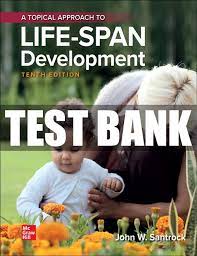Test Bank For A Topical Approach to Lifespan Development 10th edition By John Santrock
Digital item No Waiting Time Instant DownloadISBN-13: 978-1260060928 ISBN-10: 1260060926
In Stock
Original price was: $65.00.$35.00Current price is: $35.00.
Test Bank For A Topical Approach to Lifespan Development 10th edition By John Santrock
Chapter 03Test Bank1. According to the cephalocaudal growth pattern, which of the following is/are likely to show fast growth first?A. legsB. handsC. stomachD. headAPA Outcome: 1.2: Develop a working knowledge of psychology’s content domainsAccessibility: Keyboard NavigationBloom’s Taxonomy: UnderstandDifficulty Level: BasicGradable: automaticPage: 88Learning Objective: Discuss major changes in the body through the life span.Topic: Patterns of Growth2. According to the proximodistal growth pattern, which of the following are likely to show growth earlier?A. feet and handsB. fingersC. toesD. legs and armsAPA Outcome: 1.2: Develop a working knowledge of psychology’s content domainsAccessibility: Keyboard NavigationBloom’s Taxonomy: UnderstandDifficulty Level: BasicGradable: automaticPage: 88Learning Objective: Discuss major changes in the body through the life span.Topic: Patterns of Growth3. Which of the following indicates that growth progresses from the top of the body to the bottom?A. lateralizationB. cephalocaudalC. sarcopeniaD. proximodistalAPA Outcome: 1.2: Develop a working knowledge of psychology’s content domainsAccessibility: Keyboard NavigationBloom’s Taxonomy: RememberDifficulty Level: BasicGradable: automaticPage: 88Learning Objective: Discuss major changes in the body through the life span.Topic: Patterns of Growth4. In prenatal development, the head and its features grow in size and differentiation before the neck, shoulders, trunk, and limbs. What is this pattern of development called?A. lateralizationB. cephalocaudalC. sarcopeniaD. proximodistalAPA Outcome: 1.2: Develop a working knowledge of psychology’s content domainsAccessibility: Keyboard NavigationBloom’s Taxonomy: RememberDifficulty Level: BasicGradable: automaticPage: 88Learning Objective: Discuss major changes in the body through the life span.Topic: InfancyTopic: Patterns of Growth5. Which growth pattern indicates that growth progresses from the center of the body toward the extremities?A. sarcopeniaB. lateralizationC. proximodistalD. cephalocaudalAPA Outcome: 1.2: Develop a working knowledge of psychology’s content domainsAccessibility: Keyboard NavigationBloom’s Taxonomy: RememberDifficulty Level: BasicGradable: automaticPage: 88Learning Objective: Discuss major changes in the body through the life span.Topic: Patterns of Growth6. Baby Kassie can slap the tray of the highchair but cannot yet pick up small pieces of cereal with her fingers. This is an example ofA. the proximodistal pattern in physical growth.B. a congenital birth defect.C. a neurological disorder.D. the cephalocaudal pattern in physical growth.APA Outcome: 1.2: Develop a working knowledge of psychology’s content domainsAPA Outcome: 1.3: Describe applications of psychologyAccessibility: Keyboard NavigationBloom’s Taxonomy: ApplyDifficulty Level: ModerateGradable: automaticPage: 88Learning Objective: Discuss major changes in the body through the life span.Topic: InfancyTopic: Patterns of Growth7. Sammi was born three days ago and has lost 3 percent of her body weight. Should her parents be concerned?A. Maybe. Sammi’s parents should begin supplementing breastfeeding with baby formula and weigh her twice a day to ensure no more weight is lost.B. No. Babies normally lose between 5 and 7 percent of their body weight within the first few days after birth.C. No. Babies normally lose between 9 and 12 percent of their body weight within the first few days after birth.D. Yes. Sammi’s parents should consult her pediatrician immediately.APA Outcome: 1.2: Develop a working knowledge of psychology’s content domainsAPA Outcome: 1.3: Describe applications of psychologyAccessibility: Keyboard NavigationBloom’s Taxonomy: ApplyDifficulty Level: ModerateGradable: automaticPage: 89Learning Objective: Discuss major changes in the body through the life span.Topic: InfancyTopic: Weight8. Average North American babies double their birth weight by what age?A. 1 monthB. 4 monthsC. 8 monthsD. 10 monthsAPA Outcome: 1.2: Develop a working knowledge of psychology’s content domainsAccessibility: Keyboard NavigationBloom’s Taxonomy: RememberDifficulty Level: BasicGradable: automaticPage: 89Learning Objective: Discuss major changes in the body through the life span.Topic: InfancyTopic: Weight9. Marcia’s baby boy weighed 8 pounds at birth. If he grows at an average rate for an American baby, what should he weigh by 4 months of age?A. 10 poundsB. 12 poundsC. 16 poundsD. 24 poundsAPA Outcome: 1.2: Develop a working knowledge of psychology’s content domainsAPA Outcome: 1.3: Describe applications of psychologyAccessibility: Keyboard NavigationBloom’s Taxonomy: ApplyDifficulty Level: ModerateGradable: automaticPage: 89Learning Objective: Discuss major changes in the body through the life span.Topic: InfancyTopic: Weight10. During the second year of life, a child’s growth rateA. slows considerably.B. remains the same as the growth rate in the first year of life.C. accelerates considerably.D. accelerates for physical characteristics and slows for mental processes.APA Outcome: 1.2: Develop a working knowledge of psychology’s content domainsAccessibility: Keyboard NavigationBloom’s Taxonomy: RememberDifficulty Level: BasicGradable: automaticPage: 89Learning Objective: Discuss major changes in the body through the life span.Topic: InfancyTopic: Weight11. Beginning in early childhood, girls have more __________ tissue than boys, and boys have more __________ tissue than girls.A. muscle; fattyB. brain; organC. fatty; muscleD. organ; brainAPA Outcome: 1.2: Develop a working knowledge of psychology’s content domainsAccessibility: Keyboard NavigationBloom’s Taxonomy: RememberDifficulty Level: ModerateGradable: automaticPage: 89Learning Objective: Discuss major changes in the body through the life span.Topic: Early ChildhoodTopic: Weight12. During the early childhood years, girls are generally __________ than boys.A. much largerB. slightly largerC. slightly smallerD. much smallerAPA Outcome: 1.2: Develop a working knowledge of psychology’s content domainsAccessibility: Keyboard NavigationBloom’s Taxonomy: RememberDifficulty Level: BasicGradable: automaticPage: 89Learning Objective: Discuss major changes in the body through the life span.Topic: Early ChildhoodTopic: Weight13. Leon is unusually short compared with his peers. It could be becauseA. of congenital or prenatal problems.B. he suffers from a certain growth hormone deficiency.C. his mother smoked while pregnant.D. All answer choices are correct.APA Outcome: 1.2: Develop a working knowledge of psychology’s content domainsAccessibility: Keyboard NavigationBloom’s Taxonomy: ApplyDifficulty Level: ModerateGradable: automaticPage: 90Learning Objective: Discuss major changes in the body through the life span.Topic: Early ChildhoodTopic: Height14. Physical growth in middle and late childhood occursA. at approximately the same rate as in adolescenc


Reviews
There are no reviews yet.